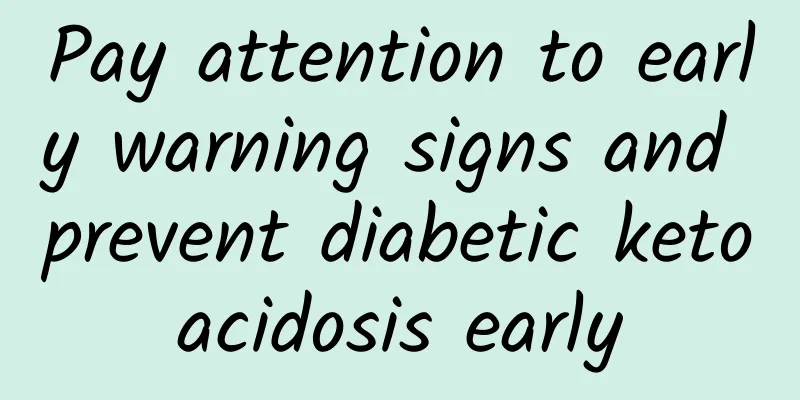Pay attention to early warning signs and prevent diabetic ketoacidosis early

|
This is the 4953th article of Da Yi Xiao Hu As a country with a high diabetes rate, in recent years, professional institutions and practitioners at all levels in my country have attached great importance to and actively carried out diabetes-related science education, which has increased the awareness of ketoacidosis, a serious acute complication of diabetes, among patients and their families. Those who have experienced it personally will have a deep understanding of the danger of this clinical syndrome. If the majority of "diabetics" or their families can recognize the risks and signals of ketoacidosis before or in the early stages of its occurrence, and take early prevention or seek medical treatment, they can achieve a better prognosis. The warning signs of diabetic ketoacidosis include some physical discomfort reactions, as well as risk factors that may induce this emergency and changing trends in key indicators. 1. Seek medical attention promptly if relevant symptoms or risk factors occur Most of the components that make up ketone bodies are acidic substances (see the "Knowledge Link" at the end of the article for details). Therefore, when a large number of ketone bodies are produced in the human body in a short period of time and cannot be metabolized in time, it will affect the acid-base balance of the internal environment and cause varying degrees of metabolic acidosis, which is ketoacidosis; if the accumulation of ketone bodies in the body has not reached the level of breaking the acid-base balance, it is ketosis. When diabetic patients develop ketosis or ketoacidosis, the signals sent by the body include: frequent urination, polyuria, thirst and polydipsia, exertion, abdominal pain, irritability, exhaled breath with a smell similar to rotten apples, and even changes in consciousness until coma. In addition to these physical discomfort reactions, there are some other situations that are risk factors for ketoacidosis in diabetic patients, including: irregular or uncontrolled diet, eating large amounts of carbohydrates after being hungry for a long time, drinking large amounts of alcohol, long-term strenuous exercise, excessive fatigue, severe work and rest disorders, severe negative emotional stimulation or continuous high tension/high stress, pregnancy, acute symptoms or diseases (such as severe vomiting, frequent diarrhea, severe infection, acute cardiovascular and cerebrovascular diseases, etc.), surgery, poor blood sugar control, improper use of insulin preparations (such as arbitrary discontinuation, reduction in dosage, etc.), etc. Diabetic patients who have the above symptoms, signs or risk signals should seek medical attention in time. Emergency or endocrinology specialists will comprehensively assess whether ketosis/ketoacidosis or other acute complications of diabetes based on the results of blood sugar, blood ketones/urine ketones and combined with relevant blood biochemical indicators such as blood pH, bicarbonate ion concentration/carbon dioxide binding capacity, urea, creatinine, potassium ion concentration, sodium ion concentration, etc., and give corresponding treatment measures. Medical staff will give patients adequate fluid replacement, continuous or intermittent supplementation of small doses of insulin, alkali supplementation, correction of electrolyte disorders and control of inducing factors according to the severity of diabetic ketoacidosis or the risk of ketosis progressing to acidosis, so that the metabolic disorder in the body can be gradually corrected to prevent further shock, organ failure and other more critical complications. It should be reminded that those who have not been diagnosed with diabetes in the past should also seek medical attention and evaluation in time when the above warning signs appear. Many diabetic patients do not realize that they are already ill, and their initial discovery and diagnosis have already manifested as diabetic ketoacidosis. 2. It is recommended that diabetic patients monitor blood ketones regularly at home to detect risks early Currently, many portable finger blood glucose monitors on the market also have the function of detecting β-hydroxybutyric acid (see the "Knowledge Link" at the end of the article for details). As long as the instrument is switched to the function of detecting blood ketones and the corresponding β-hydroxybutyric acid test strips are used, the test results can be obtained by drawing blood from the finger. Regular home monitoring of the dynamic trends of blood ketones and blood sugar can detect the risk of diabetic ketoacidosis and ketoacidosis earlier without relying solely on the discomfort of the body, and combine the control of related risk factors to promptly block the progression of complications. β-Hydroxybutyric acid ≥ 0.6mmol/L is positive for blood ketones. When the results of multiple β-hydroxybutyric acid tests are all 0.6~3mmol/L, if the random blood sugar does not exceed 11.1mmol/L, although acidosis has not yet developed, it is still necessary to actively find the possible causes of ketosis (the risk factors mentioned above) and correct them; and if the blood sugar is ≥11.1mmol/L for many times, the risk of acidosis is further increased, and even mild acidosis has occurred (even if the body's reaction is not obvious yet). At this time, you should go to the hospital as much as possible, complete relevant examinations and seek solutions to control blood sugar and ketosis. If the blood sugar value is found to be ≥13.9mmol/L many times during regular home monitoring, and β-hydroxybutyric acid is ≥3.0mmol/L, there is a high possibility of ketoacidosis or even a combined hyperosmotic state, and you need to go to the hospital in time to further improve relevant tests and diagnosis and treatment measures. It should be pointed out that with the widespread use of new oral glucose-lowering drugs such as SGLT-2 inhibitors (such as dapagliflozin, canagliflozin, empagliflozin, etc.) (see the "Knowledge Link" at the end of the article for details), in some cases, even if the blood glucose level is <13.9mmol/L, ketoacidosis may still occur when blood ketones are elevated. This rare situation is related to the characteristics of this type of glucose-lowering drugs and factors such as insufficient water intake, increased water loss, strict low-carbohydrate diet, strenuous exercise, surgery, urinary tract infection, etc. Home monitoring of blood ketones can advance the time window for detecting ketoacidosis, which is easily overlooked due to low blood sugar, and reduce the risk of serious complications. Knowledge Links ① Ketones and ketoacidosis Including acetoacetic acid, β-hydroxybutyric acid, and acetone, which are the products of free fatty acids in the blood after being decomposed and metabolized by the liver. They can be further used by cells, especially when cells cannot obtain enough glucose. Ketone bodies become an important energy source for cells; ketone bodies not used by cells are excreted from the body with urine. When the human body's metabolic state is normal, the amount of ketone bodies produced is not large, and most of them can be further used and decomposed by cells, so the amount of ketone bodies excreted with urine is very small; when various reasons cause excessive production of ketone bodies, the ketone bodies in the urine also increase accordingly and can be detected. About 98% of the three components that make up ketone bodies are acetoacetic acid and β-hydroxybutyric acid, and both components are acidic substances. Therefore, when the accumulation of ketone bodies in the body continues to increase, it will cause an acid-base imbalance in the body and cause acidosis. ②β-Hydroxybutyric Acid Under normal circumstances, β-hydroxybutyrate can be further converted into acetoacetate, and the ratio of the two is about 2~3:1; but under pathological conditions, the conversion of β-hydroxybutyrate into acetoacetate is blocked, causing the ratio of the two to increase to 16:1. Therefore, detecting blood β-hydroxybutyrate concentration can better reflect the aggravation or improvement of pathological conditions. However, the blood ketones measured by ordinary methods only include acetoacetate and acetone, and the methods and instruments for specific detection of β-hydroxybutyrate have higher application value. SGLT-2 inhibitors That is, sodium-glucose co-transporter-2 inhibitors, commonly used ones include dapagliflozin, empagliflozin, canagliflozin, etc., which lower blood sugar by promoting the excretion of glucose from the urine, while also promoting the excretion of sodium ions and taking away more water. Therefore, when using this type of drug, it is necessary to ensure sufficient water intake to ensure that the increase in urine volume does not cause dehydration. If there is a lack of body fluid when taking this type of drug, and there are factors that increase ketone body production at the same time, it may cause obstacles to the excretion of ketone bodies through urine. Although blood sugar can be controlled within a safe range, ketoacidosis may still occur. Author: Shuguang Hospital Affiliated to Shanghai University of Traditional Chinese Medicine Emergency Department He Miao |
<<: Pancreas is on the brink of death again
>>: Don't worry about puncture bruises, just deal with them and get rid of them easily
Recommend
What to do if you get angry during pregnancy
I believe everyone knows that you need to pay att...
How long after a meal is it better for pregnant women to eat fruit
It is definitely necessary for us to eat fruits f...
Can I eat pumpkin during menstruation?
Menstruation is a period that almost every woman ...
Can I go out the next day after an abortion?
Many women feel very inconvenienced if they are p...
When pre-prepared dishes appear on the New Year’s Eve dinner table, what will you choose?
Pre-prepared meals are popular among many consume...
What happens if the placenta is low
It is a very difficult process for women to get p...
Does men's skin age faster than women's?
As the years go by, our skin starts to show the s...
Why did the emperors in ancient times offer sacrifices to heaven on Mount Tai? How many temples are there on Mount Tai?
Mount Tai is famous for its magnificent scenery. ...
Silver Age Health | Elderly people should first understand their physical constitution and then “eat” accordingly
▏Why do we need to identify and intervene in TCM ...
The last fall in life: Grandma and the dilemma of one million elderly people in their later years
In January 2021, my grandmother’s painful later l...
How to restore the uterus after induced abortion
In our lives, many people need to undergo induced...
A woman drinks a bowl of Tremella and red dates soup every day
Women nowadays are under great pressure every day...
Are blood pressure medications addictive? This is a typical misunderstanding of medicine!
Written by Xu Sijia (Kyoto University School of M...
Is it true that the vagina becomes loose after abortion?
Modern people generally choose abortion after exp...
Small blisters on the outside of the labia majora
We all know that there are always bacteria and ot...









